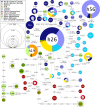The phylogenetics of Anguillicolidae (Nematoda: Anguillicoloidea), swimbladder parasites of eels
- PMID: 22559142
- PMCID: PMC3503875
- DOI: 10.1186/1471-2148-12-60
The phylogenetics of Anguillicolidae (Nematoda: Anguillicoloidea), swimbladder parasites of eels
Abstract
Background: Anguillicolidae Yamaguti, 1935 is a family of parasitic nematode infecting fresh-water eels of the genus Anguilla, comprising five species in the genera Anguillicola and Anguillicoloides. Anguillicoloides crassus is of particular importance, as it has recently spread from its endemic range in the Eastern Pacific to Europe and North America, where it poses a significant threat to new, naïve hosts such as the economic important eel species Anguilla anguilla and Anguilla rostrata. The Anguillicolidae are therefore all potentially invasive taxa, but the relationships of the described species remain unclear. Anguillicolidae is part of Spirurina, a diverse clade made up of only animal parasites, but placement of the family within Spirurina is based on limited data.
Results: We generated an extensive DNA sequence dataset from three loci (the 5' one-third of the nuclear small subunit ribosomal RNA, the D2-D3 region of the nuclear large subunit ribosomal RNA and the 5' half of the mitochondrial cytochrome c oxidase I gene) for the five species of Anguillicolidae and used this to investigate specific and generic boundaries within the family, and the relationship of Anguillicolidae to other spirurine nematodes. Neither nuclear nor mitochondrial sequences supported monophyly of Anguillicoloides. Genetic diversity within the African species Anguillicoloides papernai was suggestive of cryptic taxa, as was the finding of distinct lineages of Anguillicoloides novaezelandiae in New Zealand and Tasmania. Phylogenetic analysis of the Spirurina grouped the Anguillicolidae together with members of the Gnathostomatidae and Seuratidae.
Conclusions: The Anguillicolidae is part of a complex radiation of parasitic nematodes of vertebrates with wide host diversity (chondrichthyes, teleosts, squamates and mammals), most closely related to other marine vertebrate parasites that also have complex life cycles. Molecular analyses do not support the recent division of Anguillicolidae into two genera. The described species may hide cryptic taxa, identified here by DNA taxonomy, and this DNA barcoding approach may assist in tracking species invasions. The propensity for host switching, and thus the potential for invasive behaviour, is found in A. crassus, A. novaezelandiae and A. papernai, and thus may be common to the group.
Figures







References
-
- Kuwahara A, Itagaki H, Itagaki H. Studies of a nematode parasitic in the air bladder of the eel: 1. Description of Anguillicola crassus n. sp. (Philometridae, Anguillicolidae) Japanese, Journal of Parasitology. 1974;23:275–279.
-
- Moravec F, Taraschewski H. Revision of the genus Anguillicola Yamaguti, 1935 (Nematoda: Anguillicolidae) of the swimbladder of eels, including descriptions of two new species, A. novaezelandiae sp. n. and A. papernai sp. n. Folia Parasitol. 1988;35:125–146. - PubMed
-
- Moravec F. Dracunculoid and anguillicoloid nematodes parasitic in vertebrates. Prague: Academia; 2006.
-
- De Charleroy D, Grisez L, Thomas K, Belpaire C, Ollevier FP. The life cycle of Anguillicola crassus. Dis Aquat Organ. 1990;8:77–84.
-
- Wang P, Zhao Y. Observations on the life history of Anguillicola globiceps (Nematoda: Anguillicolidae) Acta Zoologica Sinica. 1980;26:243–249.
Publication types
MeSH terms
Substances
LinkOut - more resources
Full Text Sources
Other Literature Sources
Molecular Biology Databases

